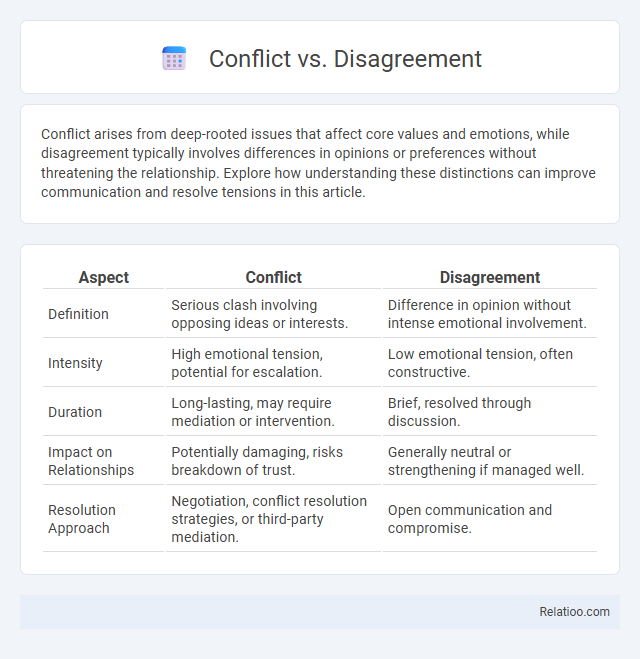Conflict arises from deep-rooted issues that affect core values and emotions, while disagreement typically involves differences in opinions or preferences without threatening the relationship. Explore how understanding these distinctions can improve communication and resolve tensions in this article.
Table of Comparison
| Aspect | Conflict | Disagreement |
|---|---|---|
| Definition | Serious clash involving opposing ideas or interests. | Difference in opinion without intense emotional involvement. |
| Intensity | High emotional tension, potential for escalation. | Low emotional tension, often constructive. |
| Duration | Long-lasting, may require mediation or intervention. | Brief, resolved through discussion. |
| Impact on Relationships | Potentially damaging, risks breakdown of trust. | Generally neutral or strengthening if managed well. |
| Resolution Approach | Negotiation, conflict resolution strategies, or third-party mediation. | Open communication and compromise. |
Understanding Conflict and Disagreement
Conflict involves a deeper clash of interests, values, or needs compared to disagreement, which often reflects differences in opinions or perspectives without emotional intensity. Understanding conflict requires recognizing underlying issues and emotional triggers, while disagreement centers on rational debate and alternative viewpoints. Addressing conflict effectively demands empathy and negotiation skills, whereas resolving disagreement benefits from open communication and critical thinking.
Key Differences Between Conflict and Disagreement
Conflict involves deeper emotional tension and often encompasses opposing needs or values, while disagreement typically centers on differing opinions or perspectives without intense personal involvement. You can resolve disagreements through communication and compromise, whereas conflicts may require mediation or conflict resolution strategies due to their complexity. Understanding these key differences helps manage interpersonal interactions more effectively.
Common Causes of Disagreements
Common causes of disagreements include misunderstandings, differences in values, and communication gaps, all of which can escalate into conflicts if not addressed timely. Personality clashes and contrasting expectations often fuel these disputes, affecting team dynamics and personal relationships. Your ability to identify these root causes early enables more effective resolution strategies and healthier interactions.
How Conflicts Escalate From Disagreements
Disagreements often begin as simple differences in opinion or perspective, which can escalate into conflicts when communication breaks down or emotions intensify. You may notice that unresolved disagreements lead to misunderstandings, decreased trust, and increased hostility, fueling conflict escalation. Effective conflict management involves recognizing early signs and addressing underlying issues before disagreements spiral into damaging conflicts.
Emotional Impact: Conflict vs Disagreement
Conflict generates intense emotional responses such as anger, fear, and frustration, often escalating tensions and leading to stress or anxiety. Disagreement typically triggers milder emotions like irritation or disappointment, allowing for more constructive dialogue and resolution. Understanding the emotional impact helps in managing interactions effectively and fostering healthier communication dynamics.
Communication Strategies for Resolution
Effective communication strategies for resolving conflict, disagreement, and misunderstanding emphasize active listening, empathy, and clear expression of perspectives to bridge differences. Utilizing techniques such as open-ended questioning, reflective feedback, and maintaining a non-judgmental tone can de-escalate tensions and promote mutual understanding. Structured communication frameworks like the Interest-Based Relational Approach and Nonviolent Communication (NVC) are essential tools for achieving collaborative resolution and sustaining positive relationships.
Benefits of Healthy Disagreement
Healthy disagreement fosters diverse perspectives, enhancing critical thinking and innovation within teams or organizations. Unlike conflict, which often escalates tensions, constructive disagreement encourages open dialogue and mutual respect, leading to better decision-making and stronger relationships. Embracing healthy disagreement promotes a collaborative environment where creative solutions thrive and continuous improvement is cultivated.
Dangers of Unresolved Conflict
Unresolved conflict poses significant risks to Your personal and professional relationships, often escalating beyond mere disagreement or simple disputes. Unlike disagreements, which typically involve differing opinions, conflicts can foster resentment, reduce collaboration, and create a toxic environment if left unaddressed. Ignoring these underlying issues increases stress, diminishes productivity, and can lead to long-term emotional and psychological damage.
Practical Examples in Everyday Life
Conflict arises when opposing interests or values cause tension, such as when team members vie for leadership roles on a project. Disagreement involves differing opinions without necessarily escalating to tension, like debating the best restaurant for a group dinner. You can manage disagreements by focusing on facts and communication, whereas conflict often requires negotiation and compromise to resolve underlying issues.
Building Constructive Dialogue and Understanding
Conflict arises when opposing interests or emotions escalate, while disagreement involves differing opinions without hostility, and argument often includes intense exchange of viewpoints. Building constructive dialogue requires active listening, empathy, and focusing on common goals to transform conflict and disagreement into opportunities for mutual understanding. Your ability to navigate these dynamics fosters collaboration and strengthens relationships through respectful communication.

Infographic: Conflict vs Disagreement
 relatioo.com
relatioo.com